Six environmental groups sued the U.S. Fish and Wildlife Service on Thursday, aiming to keep endangered species protections for wolves, which have largely recovered in northern Minnesota but are still gone from most of their native range in the United States.
The Fish and Wildlife Service delisted the wolf throughout the Lower 48 in October, saying the population was high enough that federal protections were no longer warranted. The decision, if it withstands Thursday's legal challenge, will turn over wolf management to each individual state, potentially reopening hunting seasons and allowing ranchers, farmers and others more leeway to shoot wolves that are stalking livestock or pets.
While wolves are doing well in Minnesota, they are just starting to recover in places such as California, which has a single gray wolf pack, and in the Pacific Northwest, the groups said in their lawsuit.
The loss of federal protections could mean wolves would remain absent from large swaths of the country, said Bonnie Rice, endangered species campaign representative at the Sierra Club, one of the six national groups that filed the lawsuit.
The decision to delist throughout the entire Lower 48 was "based on politics, not science," Rice said.
Gray wolves have exceeded "all conservation goals for recovery," Vanessa Kauffman, spokeswoman for the Fish and Wildlife Service, said in a statement. "This action reflects the determination that this species is neither a threatened nor endangered species."
The service delisted the "Great Lakes gray wolves," which include Minnesota's, in 2011. The wolves, however, were relisted in 2014 after a federal judge reinstated the federal protections.
Minnesota is the only state, other than Alaska, that has never lost its entire wolf population. The wolves were eradicated throughout the rest of the country by the 1930s and 1940s, but between 350 and 700 wolves were able to survive in the remote woods of northern Minnesota. Numbers started quickly growing after the state stopped offering bounties for wolf hides in the 1960s and grew further when the animals were given federal protections in the 1970s.
There are now about 2,700 wolves in Minnesota, well above the state's recovery goal, accounting for nearly half of the estimated 6,000 gray wolves left in the Lower 48.
Greg Stanley • 612-673-4882

Trail section at one of Minnesota's most iconic spots closing for rehab

Will 'shotgun only' zone for deer in southern Minnesota be abolished?

Four Minnesotans catch salmonella in outbreak linked to basil sold at Trader Joe's

